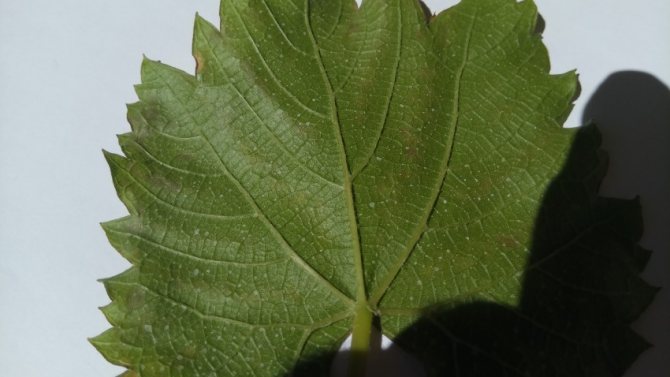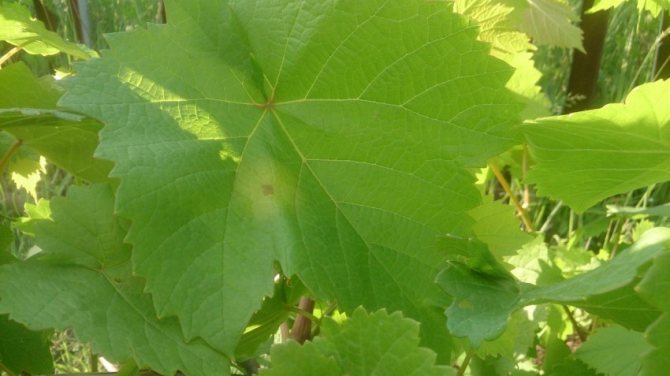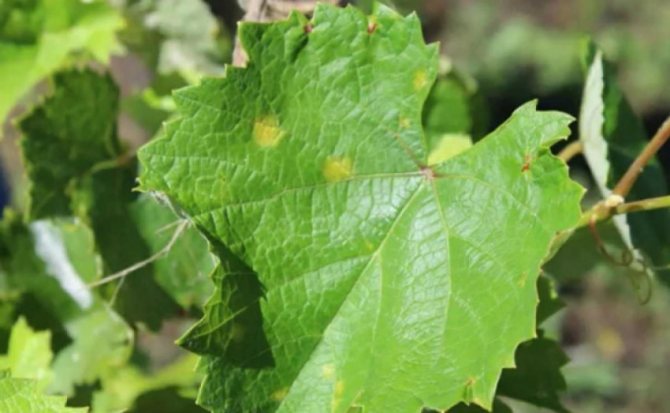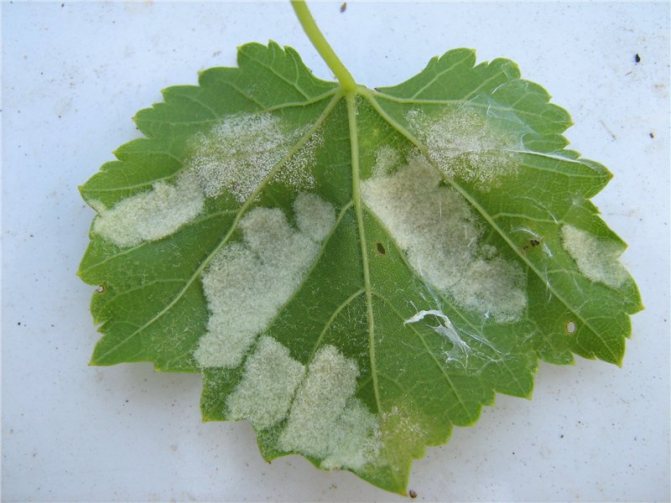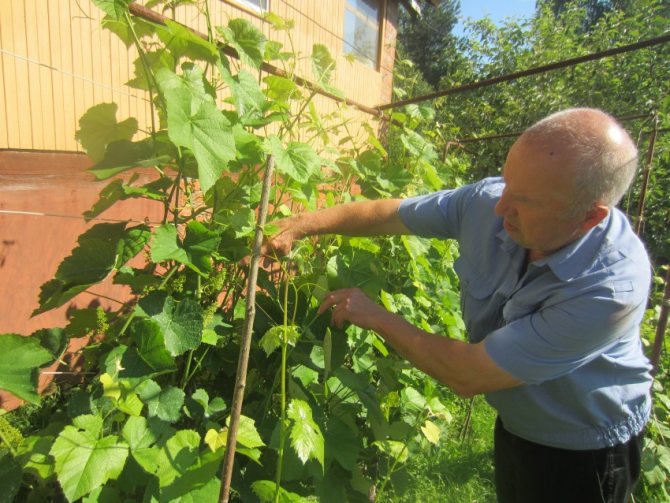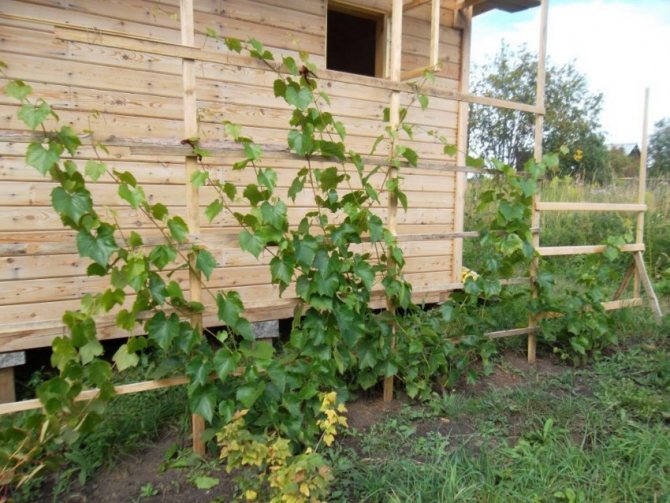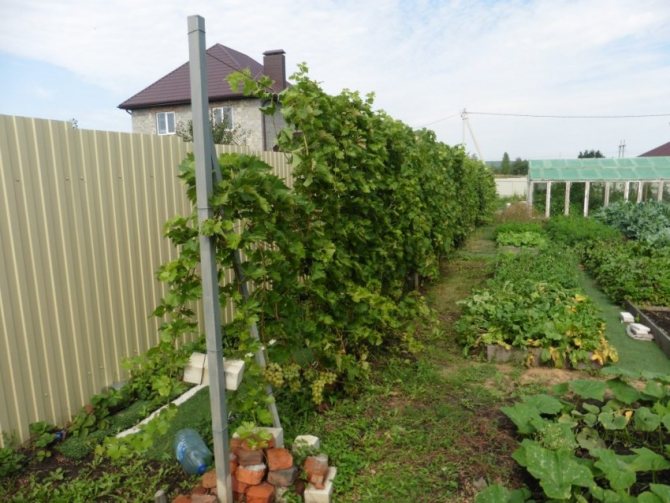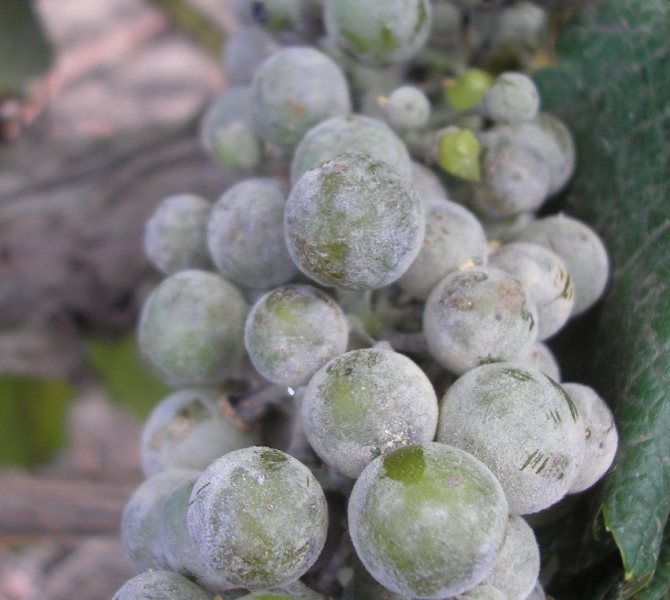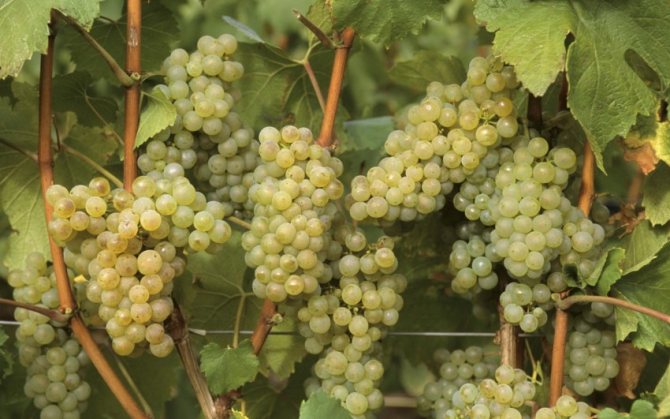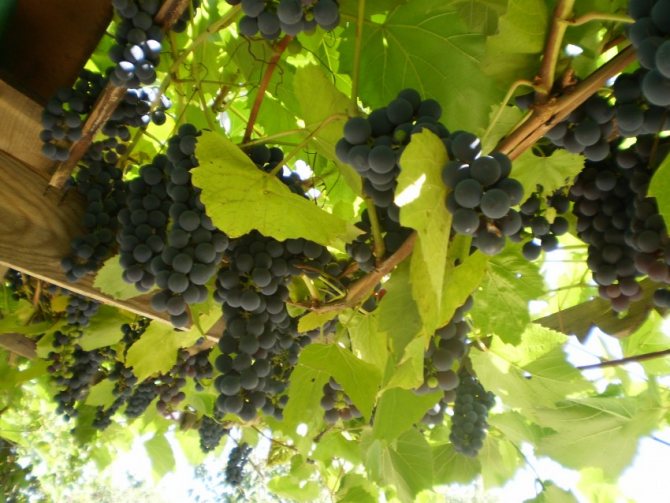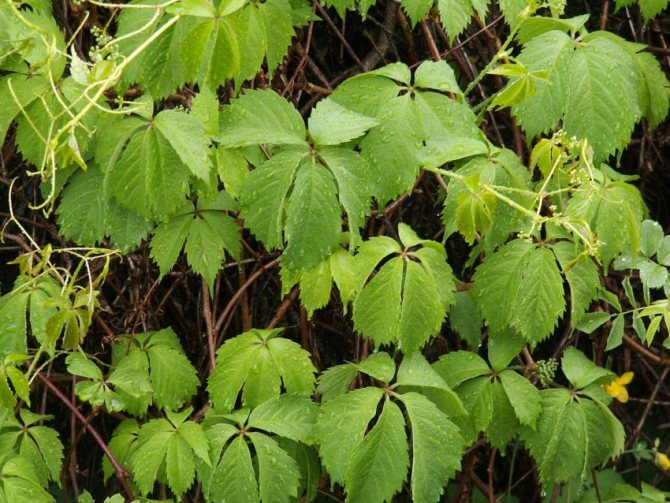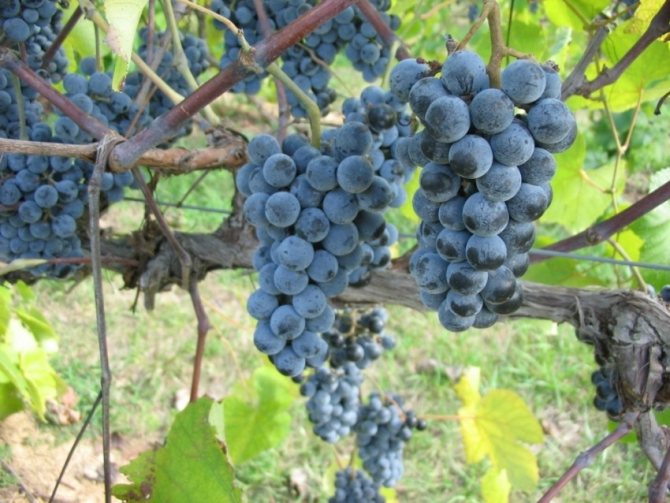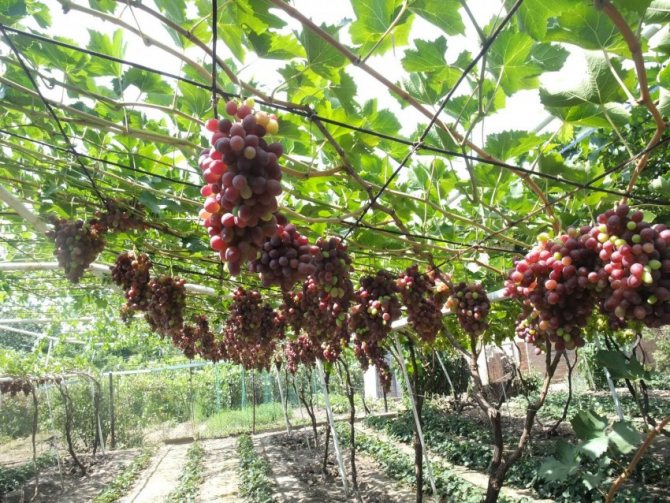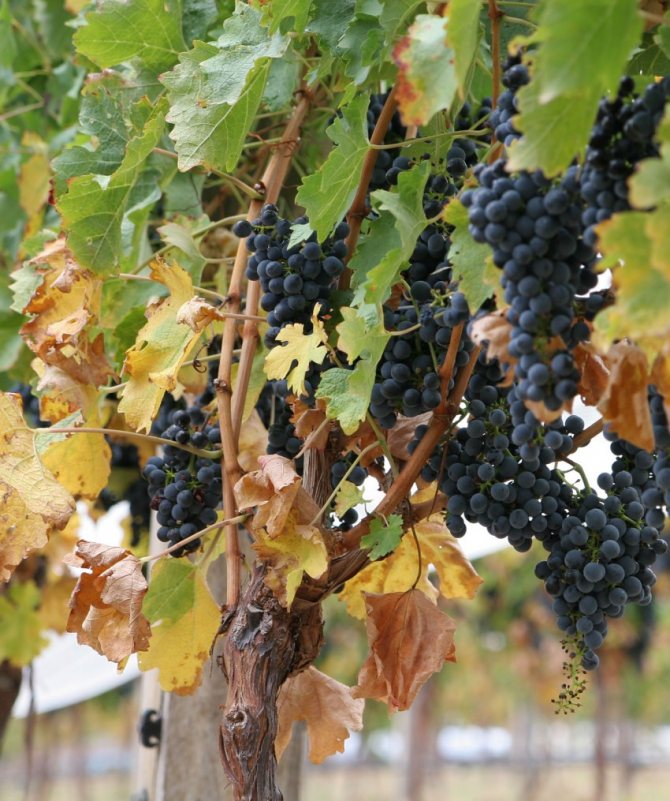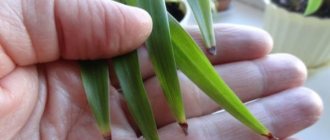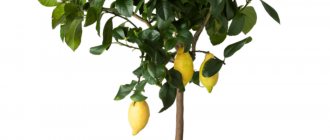Viticulture is an interesting business, but it requires patience and strength. Experienced wine growers always carefully examine the bushes in search of alarming symptoms of diseases or pest attacks. The most accurate sign is that the leaves of grapes dry at the edges and curl.
Gardeners who do not yet have experience begin to look for answers to the question of why grape leaves dry. Anything can be the cause of wilting, but they all say that the coming harvest may be spoiled. Often the cause of this symptom is disease. If you miss the initial stage of the development of the disease, the disease can spread to the entire vineyard and get rid of it will be extremely difficult.
Dry-handed grapes
The vine disease caused by the fungus Eutypa lata is widespread in all wine-growing regions where winters cannot be called mild, and is particularly damaging in seasons with high rainfall.
Since the pathogenic fungus is able to penetrate the tissues of not only grapes, but also many other horticultural and fruit crops, this complicates the fight against the manifestations of the disease and its spread. The disease affects not only shoots and berries, changes in the wood caused by the fungus are clearly visible in the photo of the grape disease.
Shoots and leaves are stunted, oh, the size and color are different from healthy ones. The leaves dry on the grapes, and then necrosis affects the affected shoots. The set berries dry up or stop growing, and remain small until the end of the growing season.
Infectious chlorosis
Infectious chlorosis is much worse than non-infectious. Such chlorosis is also called yellow mosaic or panache, it begins to manifest itself in early spring. It is caused by nematodes that infect grape bushes, that is, chlorosis itself is secondary. Unfortunately, treatment for such a disease is not possible because it is viral. The development of the disease is somewhat different from the non-infectious variant. First, the part of the leaf closest to the veins turns yellow.
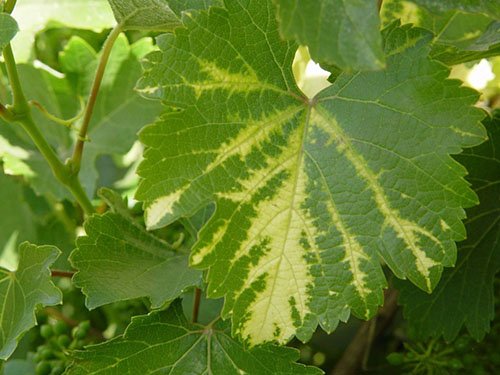
With infectious chlorosis, the leaf begins to turn yellow from the center
Nematodes live on roots. Both larvae and adult worms are dangerous. Grapes infected with such chlorosis almost always die. To protect other bushes on the site from infection, the infected bush is destroyed, and the soil around it is disinfected. In this place, grapes are not planted for at least five years. Fortunately, infectious chlorosis is not widespread in Russia..
Do your grape leaves turn yellow and dry? find out what to do
If you walk around the vineyard every day, carefully examining all the plants, paying attention to the slightest deviation from the appearance, then almost any disease can be detected at an early stage. Drying of the greenery indicates that the disturbance in the development of the grapes has gone quite far.
Water your grapes regularly in hot weather. It is necessary to water at the root, make sure that the water is absorbed into the ground, and not spread around.
If you know the acidity of the soil on the site and follow the fertilizing schedule, you can avoid the development of chlorosis. If you noticed signs of a lack of nutrition - feed the grapes, add the missing trace element to the soil. This will prevent all the greenery from drying out.
With verticillary wilting, partial pruning, foliar feeding and regular watering will help.
Any insecticide helps with spider mites.
The edges of grape leaves most often dry out when there is a lack of potassium in the soil. Usually, it is enough just to feed the grapes with potassium sulfate in a dissolved form, because the liquid fertilizer is absorbed faster by the root system.
- Why do grape leaves turn yellow
- Spots on the leaves of grapes
- How to plant grapes correctly: terms, requirements and methods
- White bloom on grape leaves
- Did the grape leaves turn red: lack of trace elements, insects or fungus?
- Harvesting grape leaves for dolma
- How to plant grapes with cuttings in the fall
- Why grapes burst and what to do
The most common cause of drying and yellowing of leaves is irregular watering. The fact is that grapes are quite hygrophilous, and they need to be watered at least twice a month, soaking the soil to a depth of 40 cm. You will need about 2-3 buckets of water per plant. First of all, the lower leaves of the grapes turn yellow, and then the whole bush. Therefore, if you notice such symptoms during dry weather, urgently moisten the soil (provided that possible diseases are excluded).
In dry weather, it is necessary to stop watering the grapes only during the flowering period and two weeks before harvest.
Also, the grapes may lack sunlight. In such a situation, the leaves brighten evenly, and then dry out. Temperature extremes and high humidity have a negative effect on the vine. In this case, the topsoil should be loosened more often and sprayed with phosphorus (30 g of superphosphate per 10 l of water).
Lack of nutrition is also bad for the appearance of the vine. The yellow edges of the leaves indicate that the plant lacks potassium. In this case, carry out an urgent spraying with potassium sulfate (10 g per 10 L of water, you can add 4 ml of iodine and 10 g of baking soda to the solution).
Yellowing of the leaves is often accompanied by other symptoms, which can be used to determine the presence of the disease. Let's consider them in more detail.
Increasingly, grapes can be found in summer cottages. This heat-loving shrub, thanks to the efforts of breeders, was able to take root in the middle lane.
But even with the most careful care, plants sometimes get sick, and the harvest is threatened. We have already told you why the leaves of grapes turn red. And today we will figure out why the leaves of grapes turn yellow, and how you can save the plant from dangerous diseases and prevent their spread throughout the vineyard.
Many summer residents immediately think: how to spray the grapes if the leaves turn yellow? But do not rush to treat the plant, first you need to understand the reasons, otherwise the treatment procedures may be ineffective.
Regular inspection of the vine will allow timely detection of grape disease when the leaves turn yellow
What to do if the grapes are already dry
Why do tomatoes curl leaves
Young grape stems can dry out due to cold winters. To reanimate the bush, you need to take a film of roofing material 50 × 50 cm and make a hole with a diameter of 10 cm in it. Next, the cuttings are dug up to the heel roots, from which new buds will appear in the future. The bush is covered and watered with water and fertilizer for rapid growth. After 3 weeks, the result will appear.
If the leaves begin to acquire an unusual shade or spots appear on them, this is a sign of the appearance of a disease and a signal that measures must be taken to destroy the disease. First, it is important to figure out what kind of ailment hit the vineyard. Early detection and treatment of a disease can save crops and even an entire plantation.
Spotted anthracnose grape
One of the reasons why grapes dry out may be anthracnose.The peak of infection with this serious disease occurs during wet periods, and the pest is active not only in warm weather, but in the range of 2-30 ° C.
Rounded necrotic spots with a brown-black border are the zones of penetration of harmful fungi. Such spots can merge, the dried-up affected tissues inside them are destroyed, and the young leaves drying on the grapes seem to be burnt.
The disease infects all aboveground green plant organs, including the brushes. The grape disease, in the photo, presents the greatest danger to berries before flowering, when the entire brush is affected, as well as before the harvest ripens. As the disease progresses, spots characteristic of the disease form on the ovaries and ridges, after the growth of which the brush withers all or partly.
Types and varieties of cissus: photo video, names and description
Erysipelas includes over 300 plant species. The most common species listed below and some of the cultivars bred within them of such a flower as cissus can be found on this page.
Antarctic cissus (Cissus antarctica) more often referred to simply as cissus. It has antennae, which cling to the support. Leaves are oval, large, light green with coarsely toothed edges, ranging in size from 5 to 8 cm. The front surface is dark green, the reverse side is slightly lighter, the veins are with a slight brownish pubescence. For a year, cissus can grow by 1 m, its shoots reach a length of 3 m. Green flowers are collected in inflorescences.
Please note: in the photo - one of the types of cissus - rhomboid (Cissus rhombifolia).
Especially unassuming. Shoots are distinguished by greater refinement and elasticity, reaching 1.5 meters. They recognize it by pinnate leaves, sometimes with a reddish bloom, trifoliate leaves are composed of simple diamond-shaped leaves. Flowers of this particular species, after pollination, are formed into red berries.
Why do the leaves on grapes turn yellow and fall off?
Such symptoms are inherent in non-infectious chlorosis, a common plant disease in which the formation of chlorophyll is disrupted. As a result, the leaves turn yellow (sometimes they become bright lemon or cream), and the veins remain green. The process of photosynthesis and the growth of the vine slows down, the ovaries crumble, and after a while all the foliage falls off. The frost resistance of the plant drops sharply.
The causes of the disease are heavy alkaline soil and rainy cold weather.
If the leaves of grapes turn yellow due to chlorosis, here's the best way to process them:
- iron sulfate (50 g per 10 l of water), every 4-5 days, until the leaves turn green;
- preparations with iron in a chelated form, which is absorbed faster, for example: Antichlorosin, Mikom-reacom, etc., every 6-7 days until visible improvement.
Read next: Why pomegranate leaves fall
To prevent plants from getting chlorosis, break up the vineyard only in places with light fertile soil. Avoid frequent feeding with manure and poultry droppings. they increase the progression of the disease. Rotted humus or compost is a good alternative. Mineral fertilizers should not alkalize the soil, so give preference to potassium sulfate and superphosphate. Preventive spraying of leaves with iron sulfate (10 g per bucket of water) also helps prevent disease.
There is also infectious chlorosis (yellow mosaic), in which the leaves turn completely yellow, along with the veins. The disease is transmitted by nematodes - microscopic worms. Treatment is ineffective, so it is better to dig up the affected bushes and burn them immediately before they infect other plants. Spill the soil with boiling water or nematicides (Chloropicrin, etc.)
Chlorosis is often confused with fusarium, a dangerous fungal disease in which the space between the veins turns yellow and the flowers fall off.You can define it by this feature: the wood of the trunk turns pink, because vessels die in it. If you do not take action in time, the bush will soon die.
To combat fusarium, spray the grapes with fungicides (Ridomil Gold, Kuproksat, etc.) every week for 1-2 months. At the first signs of the disease, spraying with a 1% solution of Bordeaux liquid (2 times a month) will also help. Also, watch out for watering, do not overmoisten the soil, carry out top dressing strictly according to the schedule.
How to water and transplant a cissus houseplant
In the spring-autumn period, all indoor grapes are actively growing, so it is important to maintain constant soil moisture. This is needed, first of all, for plants with a large mass of foliage, since their water evaporates faster. In winter, only Mandianu variety and those species and varieties that do not go into hibernation in winter can be watered. At home, caring for cissus should be like this: the hotter, the more often you water. The soil needs to dry out 2-3 cm between irrigation periods. However, you cannot fill the flower, otherwise the roots will rot. If you feed the flower with water too rarely, it will dry out.
In winter and autumn, it is necessary to reduce watering to a minimum - only to maintain the life support of the roots.
Plants up to five years old need to be replanted annually, then every 2-3 years. This is due to the fact that the flower grows very quickly, and in order for it to continue to develop, it is necessary to change the pot to another - larger one. A ceramic or earthenware container is best. It should be a "breathing" pot, that is, letting in fresh air.
The soil can be taken different, with neutral or underestimated acidity. Some varieties of cissus, such as the Antarctic species, do well in hydroponics. A mixture of sod and leafy soil with an admixture of humus, peat and sand is often used. All parts are mixed in equal proportions.
The transplant is carried out in early spring, when the plant has not yet completely recovered from dormancy. Drainage is placed at the bottom of the pot, then soil and a flower is planted. You don't need to fertilize. At the same time, it is best to trim the cissus to shape it.
Verticillary wilting of the vine
Verticillium, namely the causative agent of this disease, the pathogenic fungus Verticillium dahliae, penetrates the roots through the soil and, multiplying, disrupts the supply of moisture to the shoots and clusters of grapes. The disease of grape berries, as in the photo, more often and more strongly affects young plants, and its external manifestations can become visually noticeable only a year or two after infection.
The vineyard suffers the strongest damage when the bushes are under high stress. This is more often observed with a lack of moisture, elevated air temperature and the beginning of ripening of berries. First, leaves that look like burnt dry on the grapes, then it is the turn of shoots and bunches. The clusters located in the lower tiers of the affected shoots dry, individual berries on the grapes dry, mummify and remain in this form on the bunches.
Growing conditions
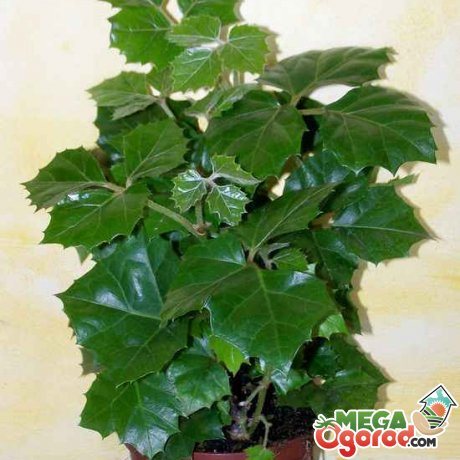

The air temperature for almost all types of indoor grapes should be 22 ° -25 °, not higher. In winter, the temperature can be reduced to 18 ° -20 °. As long as the bush is small and has not completely attached to the vertical support, it can be taken out into the fresh air in summer. Temperature drops are undesirable for cissus, especially for a two-color look. Try to avoid this.
When choosing a place for grapes, choose rooms in the east and west direction, where there are no drafts.
Indoor grapes love bright, but diffused lighting. It is better not to place it near the windows. Choose niches for it in the walls or places where sunlight will fall, but not direct sunlight. The plant is shade-loving, but dark places, without any light, are undesirable.
Why do grape leaves dry?
Many gardeners, accustomed to growing beautiful and juicy bunches of grapes, are faced with drying out of the leaves on the bushes in the summer. If the scorching sun is not the root cause of this problem, then it is recommended to study the lesions in more detail in order to independently assess them and determine the disease.
During the cultivation of the bush, you must constantly monitor its health. As soon as suspicious signs of the disease appear, it is recommended to take action immediately. This is how you can preserve the harvest and extend the life cycle of the grapes.
The most common vine leaves dry for three reasons:
- Lack of nitrogen. A characteristic sign of such a lesion is that at first the plate gradually brightens, after which it completely dries up and becomes lifeless. The problem is the lack of nitrogen in the soil. To solve the problem, they begin to fertilize the soil with various organic fertilizing and constantly monitor watering.
- The presence of pests. The most common uninvited guests are spider mites and aphids. As soon as it became known for sure that a parasite has settled on the plant, pest control is performed with special preparations. The danger of being damaged by pests lies in the lack of timely recognition of the parasite, which reduces the chances of saving the plantation.
- Infection. Those who live and grow grapes in the northern regions regularly face the problem of low temperatures. Growers cover their crops with plastic, which brings even more problems. Thus, the bush can pick up an infection or fungal infection, gradually worsening the condition of the plant.
If the basic rules of cultivation are not followed, for example, irregular watering, lack of heat, and low light, the plant becomes vulnerable. This makes it weakened, so pests and fungal infections settle on the bush without problems.
If the edges of the leaves dry out in grapes or the middle of the leaf plate has dried up, the gardener is dealing with infectious lesions. Such diseases can be cured if they are detected in a timely manner. The most common options for this symptom are:
- mildew;
- oidium;
- chlorosis;
- gray rot;
- cercosporosis;
- alternaria;
- rubella.
Such a dangerous disease as mildew is manifested by yellowing of grape leaves, after which dry places are observed in cuttings.
During wet weather, the leaves are additionally covered with a white bloom, and during drought the disease develops at a rapid rate. Spraying with chemicals is used to eliminate the problem.
If spots of ashy color are formed, after which they dry up and fall off, the grapes have hit the powdery mildew. This infectious disease can also affect the berries - they crack and rot.
If the soil is oversaturated with carbonates, chlorosis appears on the leaves. It affects the edges of the leaf plate, they turn yellow and fall off over time.
In an advanced stage, the disease affects the fruits - they become less tasty and smaller in size. Gray rot causes the leaves of the grapes to dry: this is due to the high humidity.
Gradually, the plant is completely covered with a fluffy bloom, which is carried by the wind to the surrounding shrubs.
When the leaves begin to dry from the inside, becoming covered with light brown spots, the face is affected by cercospora. In this case, it is recommended to completely cut off all infected plant elements and burn them.
The same goes for berries, which change their color to a bright lilac color. Rubella is characterized by the appearance of red dots and severe reddening of the leaf, followed by drying.
Alternaria is characterized by the appearance of dead dry areas on the plate, in addition, mold forms after rain
When the leaves on the grapes have dried up, it remains only to deal with the treatment of the bush.Bordeaux liquid against infectious diseases is suitable for this. Various insecticides can help eliminate pests, and spray fungicides can help save crops. Preventive measures will also be helpful to avoid problems:
- Purchase in specialized stores. You should not buy seedlings from your hands that have not passed confirmation of the health of the bush. The purchased seedling should look attractive and be in a developing state. It is much easier to buy contaminated grapes off hand than to do it in the store.
- Care. The grape bush will not tolerate negligence - regular watering, adherence to growing conditions will be the key to success.
- Top dressing of grapes. Chicken droppings and cow dung have performed well.
Regular inspection of the plantation will allow timely identification of diseases and pests, which will significantly increase the chances of saving the grapes.
Yellowish spots on the leaves of grapes are often signs of mildew (downy mildew), an insidious fungal disease that can quickly destroy the entire bush, along with the berries. Most often, the lesions can be seen on the upper side of the leaves. If you turn the leaf over, you will find a white coating that resembles flour.
Read more: Dried cranberries, useful properties, contraindications, application
Causes of leaf drying
There are many reasons why grape leaves can dry, and they are all different.
Lack of moisture
Drying often begins when the water regime is violated. Despite the fact that grapes love the heat, they cannot survive without water. With a lack of moisture, the berries wrinkle first, then the greens wilt. If you do not water on time, the leaves will quickly dry out and fall off.
With prolonged drought, small roots are suppressed, and nutrients cease to flow to the plant. The grape bush may die.
Lack of nutrients in the soil
Drying of greenery may be due to a lack of trace elements in the soil. If there is not enough boron or magnesium, the green part between the veins first turns yellow, then turns brown and dries up. In this case, the veins on the leaves remain green.
With a lack of nitrogen, the leaves turn yellow and dry, the shoots do not ripen, the bush itself becomes smaller.
With a lack of potassium, a dry border appears along the edge of the leaf.
Diseases
When affected by a spotted mosaic, the veins first turn yellow, then the entire tissue is covered with spots. After that, the leaf dies off.
Often the drying of the leaves, and subsequently the entire bush, is caused by pathogenic microorganisms - fungi. One of these diseases is verticillary wilting. First, the root system is affected, which ceases to perform its function and assimilate useful trace elements and water from the soil. Leaves and stems no longer receive nutrition. Drying starts from the edge of the leaf, it looks like burnt. The leaves dry out and fall off completely. Signs of the disease appear in the second or third year after infection.


The foliage problem occurs with chlorosis. Due to a lack of iron, it does not produce chlorophyll. The fabric first turns yellow, then the leaf dries up and falls off.
In case of mildew disease, light, almost transparent spots are first covered, then they become brown. In wet weather, a white bloom is visible on the lower part of the greenery. In dry hot weather, it may not be there.
Pests
The pest that causes the leaves on the grapes to dry out is the spider mite. It is very small and not always immediately visible. The cobweb at the junction of the leaf with the shoot is proof that a malicious pest attacked the grapes. If inspected regularly, it can be found on the lower part of the foliage, even before it damages a significant part of the plant.
Buffalo leafhopper
An insect that feeds on plant juices, on the shoots and ridges, makes characteristic ring-shaped lesions, up to a centimeter long, as a result of which the grapes, which are not receiving enough nutrition, dry, the shoots wither and die off.
The pest gives one generation per season. In the stage, leafhoppers larvae live and feed on grassy plants under vine bushes, and then adult insects climb the vine and begin their harmful activity.
The spread of the pest is facilitated by the abundance of vegetation near the grape bushes. A measure of the fight against a dangerous insect is a two-fold treatment of plants with benzophosphate. Such spraying should be carried out in June, and, in addition, removing weeds and planting beds with onions and garlic near the vineyard, which repels leafhoppers, will be a good prevention.
Folk remedies for disease and pest control
Garlic broth (75 g per ten liters of water) or horsetail helps well with mildew. It is necessary to irrigate the bushes with any of the decoctions. He does not like this fungus and the smell of dill, which is planted around the grapes. Foliar treatment of the vine with an infusion of wood ash is good for mildew. Insist a liter of ash for a week in a bucket of water, add 50 g of laundry soap to the hood and spray the bush from a spray bottle every week. Such processing also has a beneficial effect on the ripening of grapes and contributes to the greater sweetness of the fruit.
Important!It is not recommended to use chemical preparations during the ripening of berries. The waiting period after processing is from 14 to 60 days. In such cases, the old-fashioned methods are much more effective. In particular, mulching the soil with coniferous litter. Thanks to the substances released, grapes gain more sweetness and fungi do not infect the plant. It is best used in July-August.
Treatment with a soda solution is also very good at fighting fungi and pests, and also contributes to the accumulation of sweetness in the berry.
Any disease is better prevented than cured. It is necessary to closely monitor the vineyard in order to notice the problem on time and use less chemicals.
Why do grape leaves curl and turn yellow?
These are obvious symptoms of a common infection called leaf curling. Usually in the middle of summer, the edges of the leaves begin to curl downward. In white grape varieties, the leaf plates turn yellow, and in red ones they acquire a purple-red hue. The veins remain green, and the whole shrub becomes variegated.
Usually, the disease primarily affects the lower leaves. If curling starts at the top of the bush, the plant is most likely lacking in nutrients or moisture.
Drying grape ridges
An explanation of why berries dry on grapes can be the ripening bunches themselves, under whose weight the bunches bend, the supply of moisture and nutrients is disrupted and the fruits wither.
The risk of loss of yield for this reason is greatest for varieties and hybrids that form heavy large clusters.
You can avoid breaking the ridges and shoots bearing brushes if you grow a bush based on an arch or a gazebo. The brushes hanging down are not constrained and develop well, and the branches experience an even load and do not bend.
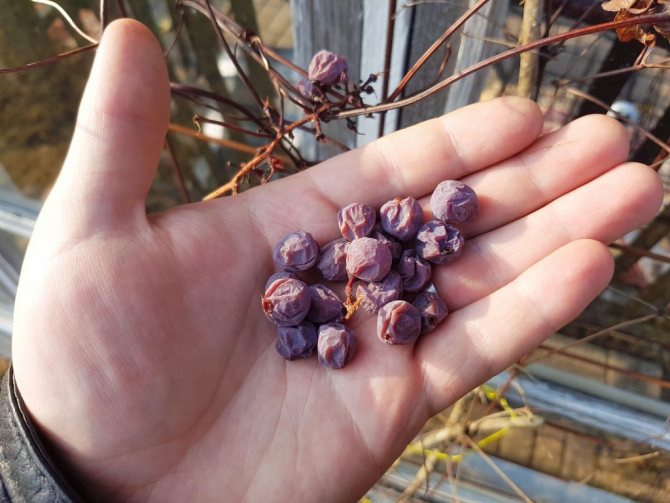

If no apparent reasons, for example, symptoms of diseases of grape berries, as in the photo, are identified, and the brushes are not poured, and the berries are mummified, perhaps we should talk about drying out of the ridges.
This phenomenon, first noticed a little more than a century ago, has not yet been sufficiently studied, it has only been found out that a kind of paralysis, leading to a slowdown or arrest of the development of bunches, is associated with metabolic disorders and is of a local nature. The disease is not infectious in nature, is not transmitted to other plants and may be associated with a violation of the ingress of moisture through the vessels of the ridge to the ripening berries.Indeed, it is in dry periods that paralysis, leading to the drying out of grapes, is most often manifested.
The tissues under the spots are affected to the depth of several layers of cells, and the lack of moisture aggravates the picture and necrosis covers all new areas. If the spot on the ridge loops back, the flow of moisture to the brush located below stops, and the isolated grapes dry out, wrinkle and lose their taste and marketability.
A direct relationship between the frequency of drying of the ridges, the region of growth and the grape variety was not revealed. But empirically, it was possible to determine that self-rooted bushes are less likely to be affected by this disease of grape berries, as in the photo, than grafted plants, especially on vigorous rootstocks.
Treatment of paralyzed bushes with fungicides or other plant protection products is ineffective. In some cases, when the grapes dry out, spraying the plantings with a 0.75% solution of magnesium chloride or 3% magnesium sulfate helps. Prophylaxis begins about a month before the onset of paralysis, and then two more sprays are carried out with an interval of 10 days.
However, the main means of combating the drying out of grape ridges, gardeners consider compliance with the rules of agricultural technology. Only with proper shaping and pruning of vines, the use of balanced fertilizing, including magnesium and a moderate amount of nitrogen, as well as with sufficient watering of the vineyard in combination with chemical treatment, can we talk about eliminating paralysis of the ridges and saving the crop.
Indoor grapes: structural features


Indoor grapes are perennials, evergreens with climbing vines. It grows quite quickly, vines cling to vertical objects with the help of antennae. The leaves have a variety of shapes, depending on the species and variety - whole, ternary. They are often jagged and resemble wild grapes. The plant does not bloom in indoor conditions, but sometimes this happens. Flowers are very small and inconspicuous inflorescences.
Indoor grapes are grown not for their flowering, but for their ability to cover large areas of rooms and purify the air in a short time.
The stems and shoots of the plant are rather fragile, therefore, flower growers recommend determining a place that is unique for it, so that in the future you do not have to transfer the grapes to another part of the house. Unpretentious and able to grow in any conditions. Indoor grapes are often grown in public facilities for this very reason.
The homeland of this amazing plant is America, Asia and Australia, their subtropical and tropical forests. Despite its unpretentiousness, it prefers quiet places where there are no winds, moderately humid and illuminated by diffused sunlight. It is customary to maintain the same conditions when growing it at home. Indoor grapes have a large number of species and varieties, but only a few are bred in the conditions of apartments and premises.
Why do the edges of grape leaves turn yellow?
Help the project, tell your friends:
If the edges of the leaves turn yellow in grapes, this may be a sign of a lack of magnesium and boron. At the same time, the veins remain green, and soon the entire leaf dries up. For treatment, it is necessary to bring potassium magnesium under the bush. To do this, dissolve 20 g of the substance in 10 l of water and spray the plants during the ripening period with an interval of 3 weeks.
These signs can also be symptoms of verticillus (verticillus wilting, wilt) - a fungal disease that is activated in summer. The causative agent of the disease is the fungus Verticillium dahliae, which affects the roots, which disrupts the nutrition of the plant. The edges of the leaves are covered with yellow burns, then wither and fall off, the stems and bunches dry out.
Reproduction methods
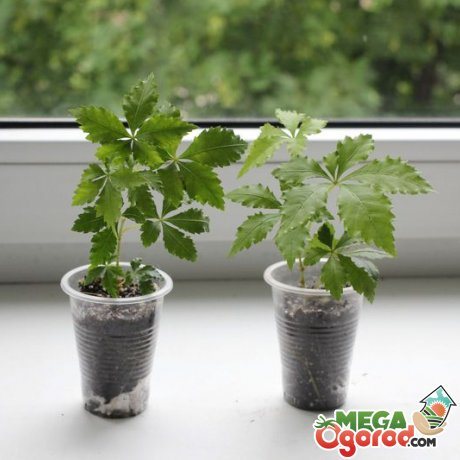

It is very easy to propagate cissus.To do this, use the grafting method:
- From an adult, preferably two years old, the plants are cut off the apical shoots. They must have at least two kidneys.
- Cut cuttings are placed in water and are waiting for the roots to appear.
- A glass of water can be avoided by immediately rooting the stalk into a light substrate.
- Once roots are established, plant the plant in a permanent pot. Florists recommend planting several cuttings in one flowerpot.
- The substrate for young plants is prepared by mixing leafy, soddy soil with peat, humus and sand, one part of each. The soil should be slightly damp.
- The desired temperature for germinating cuttings is 22 ° -23 °. Be careful with drafts. They shouldn't be.
This simple propagation method will allow the grower to very quickly breed the crop and plant it in different containers.
Why do grape leaves turn yellow in June?
Grape leaves turn yellow in early summer, most often due to infection with black spot. The causative agent of the disease is the fungus Phomopsis viticola, which parasitizes in the upper layers of plant cells.
In May-June, small black spots with a light border appear on the leaves, which gradually increase. The sheet is deformed, covered with holes. Affected leaves turn yellow and fall off, and bunches are also threatened. The berries become tasteless. The disease develops for a long time and after 5 years the plant completely dies.
Preventive measures
To prevent the culture from turning yellow, you need to properly organize its care. It is annually pruned to remove dead branches. Sanitary pruning is done in the spring. The procedure ends with prophylactic treatment and fertilization of the soil. The correct approach provides plants with nutrients, allows you to destroy fungal spores and pest larvae.
After pruning, all plant waste must be disposed of. The soil is dug to a depth of 15 cm. Nitrogen fertilizers or superphosphates are applied. Before flowering, the leaf plates are treated with copper sulfate. After flowering, potassium fertilizers are applied.
Growing grapes Why do grape leaves turn yellow
Grapes. Chlorosis of grape leaves. Methods of combating this disease.
Grape leaves turn yellow, what should I do?
In the spring, before the kidneys swell, they are treated with insecticides ("Nitrafen"), if there have already been incidents with diseases. In the fall, a similar procedure is performed. Treatment with chemicals, if necessary, continue throughout the season until the grapes are poured. In the fall, the vine is wrapped in burlap.
There are a number of biostimulants available that can accelerate growth, increase yields, and protect against pests. Nutrient complexes include a number of trace elements and phytohormones that activate the protective functions of the plant organism. The preparations are applied at any stage of the growing process in the form of root and foliar dressings. They increase the yield increase by 10-50%. The most popular products in this group are Kornevin, Zircon, Stimax Harvest, Universal.
In order to avoid yellowing and drying of the leaves, the following preventive measures must be taken:
- Choose a well-lit area for planting, ideally from the south or southwest side, where the bushes will receive a sufficient amount of sunlight from morning to 3 pm.
- When planting, exclude the close occurrence of groundwater on the site in order to avoid root decay.
- Plant the plant away from trees - at a distance of at least 3 m to exclude shadows.
- To prevent infection with mildew, mildew and harmful insects, plant dill in the immediate vicinity of the grapes.
- Before planting, properly prepare the soil on the site. In a month, add manure (10 kg / 1 m2), wood ash (150 g / 1 m2) and fill in high beds. For 2 weeks, dig holes for the bushes, adding in layers of drainage, humus (2 buckets), superphosphate (500 g), wood ash (1 kg).The soil is prepared from 2 parts of sod land and 1 part of sand.
- Plant vines in sandy, loamy, clayey and sandy loam soil.
- Regularly - once every 1-2 weeks - water the bushes, using 10 liters under the bush.
- In order for mineral dressing to penetrate well to the roots, it is necessary to regularly loosen the soil in the near-stem zone.
- In the spring and summer, it is imperative to carry out preventive spraying: in the spring, upon reaching the shoots of 10 cm, with Bordeaux liquid, copper oxychloride and colloidal sulfur; before flowering - "Strobe" or other systemic fungicide; after flowering (in July) - the mixture used in the first treatment.
- In April, tie the plant to the trellis or supports.
- In early spring and late autumn, after harvest, prune the vines.
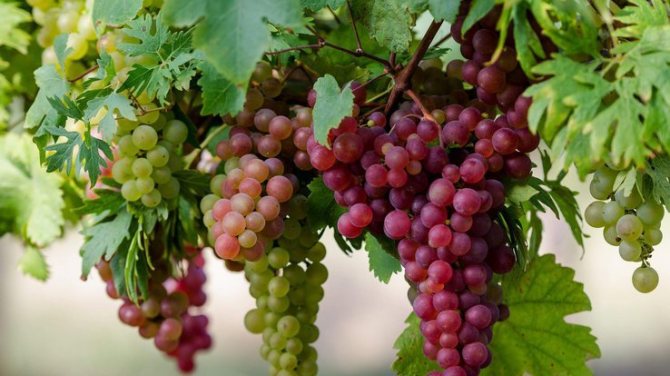

- Remove weeds in a timely manner. This will prevent the spread of diseases and pests.
- To preserve moisture, prevent soil clogging and damage to roots during loosening, mulch the soil in the near-trunk zone.
- In late autumn, carry out a thorough cleaning and digging of the site in order to exclude the wintering of pathogens and pests.
- In November, it is good to water and cover the trimmed bushes.
- During the season for mature plants, apply 5 root dressings (before the beginning of the growing season, before flowering, before the formation of ovaries, before harvesting, in the fall), the first 3 of which must contain nitrogen:
| Application time | Fertilizer options |
| before the beginning of the growing season (at an air temperature of 16 ° C) | 1. Superphosphate (20 g) potassium salt (5 g) ammonium nitrate (10 g). Consumption - 10 l / 1 bush. 2. Complex fertilizer. |
| before flowering (in June) | 1. Superphosphate (20 g) potassium salt (5 g) ammonium nitrate (10 g) boric acid (5 g). Consumption - 10 l / 1 bush. 2. Nitrofos (60–70 g / 10 l). 3. Mullein (2 kg / 5 l): leave for 2-3 days, dilute with water to 12 l. 4. Bird droppings (50 g / 10 l), leave for 2-5 days. |
| at the end of flowering | Kalimagnesia (10 g) ammonium nitrate (20 g) water (10 l). |
So, grapes require certain conditions for growth and successful fruiting, as well as regular quality care. If the owner of the site responsibly approaches these issues, then the berry plant will certainly delight you with a plentiful and tasty harvest, and its leaves will remain green until autumn.
Consequences of rolling leaves
Initially, it seems that the leaves are always curled the same way. In fact, they can twist in different ways, depending on the cause of this phenomenon:
- leaves tend upward and curl. As a rule, this is caused by the defeat of the virus. In this case, the leaves of the grapes often curl into a tube and dry around the edges;
- the leaves go down and curl. This is due to the lack of nutrients in the soil. Usually, the problem is also accompanied by drying of the edges of the foliage;
- leaves are curled in any shape. Usually the problem is caused by inappropriate climatic conditions.
Read next: How to plant and care for wild grapes on the fence
The flow of nutrients inside the plant is disrupted and becomes insufficient for healthy development. As a result, the plant organs lack nutrients. This leads to a deterioration in the qualitative and quantitative indicators of the harvest, the size of the berries decreases, and the taste deteriorates.
It is impossible to protect yourself from viral diseases, and they will have to be treated with the help of special drugs. But, the lack of nutrients will help to exclude the correct preparation of the soil. If the soil on the site is completely infertile, it should be replaced. Bring in the required amount of fertile soil and lay it on top of the available soil.
Apply organic fertilizers such as humus. For each square meter of area, it is worth making 1-2 buckets of humus.
You can apply special potash, phosphorus and other fertilizers to the soil. On sale there are special complexes for fertilizing the soil for grapes.Of course, it is better to use organic fertilizers, but if they are not available, others will do.
First Steps When Finding Yellow Leaves


- If you notice yellow foliage on the grapes, you should do a thorough inspection of the plant. Find the reason. You may notice a pest or spores. If there is neither a dispute nor a pest, proceed to inspect the diseased leaf. Find the beginning of yellowing, whether the leaf is curling or not. If so, shed the bush.
- If there are bumps on the leaves, rats or mice are in the ground. You can get rid of them with deterrent drugs. As well as accessories. When the growth stops or the vines dry up, it is possible to assert the presence of root rot.
- If a whole leaf turns yellow at once, this means the presence of chlorosis. It is treated with fertilizers containing iron, nitrogen and potassium. And you can also shed and treat the surface and soil with iron vitriol.
- If there are any insects inside the leaf, get rid of the infected leaves. And also spray with insecticides.
- Very often, a yellowish-burgundy spot appears in the center of the leaf. It turns black over time. This means the presence of black rot or powdery mildew.
Inadequate nutrition of grapes
Very often the reason why grape leaves curl is lack of nutrition. Lack of oxygen can cause leaves to curl. This can be caused by weather conditions. For example, during prolonged rains, oxygen is squeezed out of the soil. Due to the violation of aeration, the tissues of the plant do not have enough oxygen.
As a result, the leaves tend to compaction, as a result of which they curl. The area of the leaf decreases, at the edges it begins to dry, so that the main part has enough available oxygen.
A similar problem occurs with over-watering. In this case, you should stop watering and loosen the soil.
Lack of moisture can also lead to curling and drying of leaves along the edges.
If there is little potassium in the soil, the leaves will curl downward. First, the leaves lighten, dry areas appear at the edges, then they acquire a brown color and begin to go down. The lack of potassium also leads to a delay in the ripening of berries, they turn out to be small and sour. To solve the problem, it is necessary to apply potash fertilizers to the soil.
With a lack of phosphorus, young foliage will have a darker shade, unlike old ones. The edges of the leaves begin to dry out and stretch upward. The foliage that is near the ground is directed downward in the opposite direction. Due to the lack of phosphorus, the condition of the roots deteriorates, the yield decreases.
Often, several components are missing in the soil at the same time. The cause in this case is difficult to determine, since the symptoms are mixed. Therefore, in such a situation, it is recommended to use complex fertilizers for feeding grapes.
Prevention measures
So that young grapes do not suddenly stop growing, and during the ripening period of berries they do not dry out and do not crumble from the brushes, it is important to follow several simple recommendations for caring for the plant:
- make sure that all purchased seedlings are healthy, and when disembarking, select only places well-lit by the sun without the possibility of flooding by melt or rainwater (avoid areas with cold gusts of wind);
- after planting the plant on the territory, provide it with timely and moderate wateringby introducing liquid only after the upper soil layer has dried to a depth of at least 1-2 cm;
- to organize good air exchange, be sure to surface loosening of the substrate (preferably the next day after watering);
- both ready-made complex mixtures and self-prepared solution from mullein or chicken droppings can be used as nutritional compositions, but in this case, only the use of an infusion diluted in water is allowed;
- when grown in unfavorable areas, especially in places where cases of grape disease with fungal or infectious ailments have already been recorded, it is advisable to carry out preventive spring treatments with one of the popular fungicidal preparations (for example, "Topaz");
- inspect plants regularly for insects or signs of ailments, additionally removing unnecessary branches and leaves from the bush (this will improve air exchange inside the plantings and prevent them from decay).
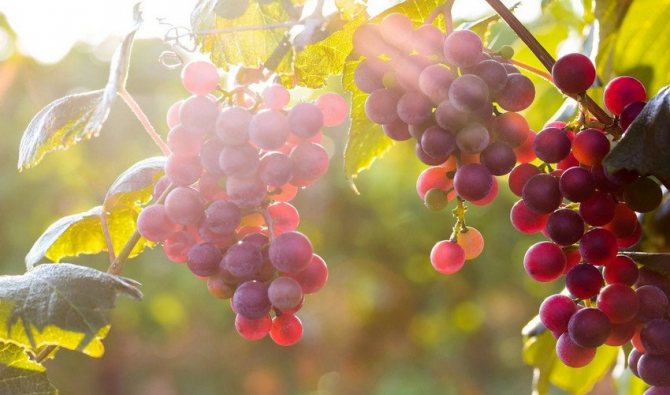

In fact, yellowing or even drying out of grapes is not a sentence to your harvest, and in most cases, with timely elimination of the cause, the bulk of the berries can be saved.
Did you know? First mentions of performance
treatment of plants from pestsdate back to 1000–800. BC e. and are associated with the name of Homer. This ancient Greek poet-storyteller in his writings mentioned the benefits of fumigating plants with sulfur, and it is possible that in those days it was used to combat the aforementioned powdery mildew and cereal rust.
However, you should not take the situation to an extreme and it is better to immediately provide the cultivated crop with all the necessary conditions for active growth and prevention of ailments.
Fungal diseases
Often, a viral disease leads to curling of leaves and drying of their edges. Symptoms of the disease usually appear closer to July, and are first noticeable on the leaves below. They begin to dry at the edges first and then curl down. In case of severe damage, the twisted leaf can form a triangle or tube shape.
When buying a new seedling for grafting, you may come across an infected plant, through which the virus will spread to healthy grapes. In addition, the symptoms of a viral disease are very similar to a lack of potassium in the soil.
Such a dangerous disease as mildew is manifested by yellowing of grape leaves, after which dry places are observed in cuttings. During wet weather, the leaves are additionally covered with a white bloom, and during drought the disease develops at a rapid rate. Spraying with chemicals is used to eliminate the problem.


When the leaves begin to dry from the inside, becoming covered with light brown spots, the face is affected by cercospora. In this case, it is recommended to completely cut off all infected plant elements and burn them. The same goes for berries, which change their color to a bright lilac color. Rubella is characterized by the appearance of red dots and severe reddening of the leaf, followed by drying. Alternaria is characterized by the appearance of dead dry areas on the plate, in addition, mold forms after rain
The grapes dry out at different points of ripening: both after they are tied, and in the process of ripening the fruits. If the wilting of the berries is combined with other symptoms, for example, the foliage is covered with spots, the problem is in one of the diseases: mildew, eutiposis, anthracnose, verticillus, buibolin leafhoppers.
If the bush begins to hurt, treatment is best done before winter: this way there are more chances to save the bush. As a preventive measure, 2 treatments of the bush are carried out per season: this reduces the risk of ailments.
Mildew
The berries on the grapes wither because of the mildew. The disease spreads quickly, so treatment is needed for all healthy grape bushes. In another way, the disease is called downy mildew. The disease affects the brushes, ridges, berries, leaves, perennial and young shoots.
If the bush has not been processed and the fungus has penetrated into the fibers of the bush, nutrition, the flow of moisture is upset, the berries dry on the grapes, and then die off.
Euthyposis
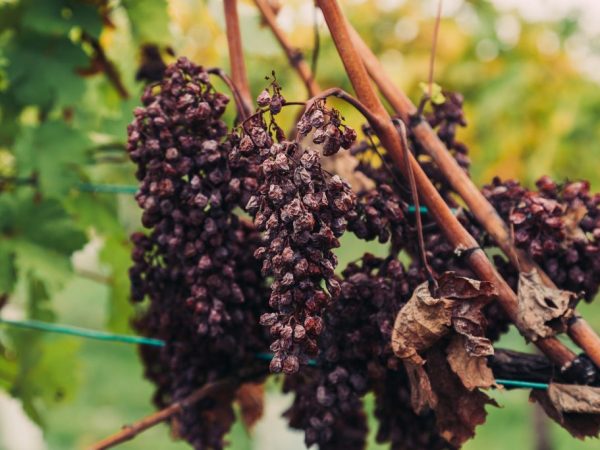

Disease can kill an entire crop
In the people, eutiposis is called dry-handedness in another way.
The wood of the vine suffers from the disease, which slows down the growth and development of shoots, leaves, berries. The berries that have set are small, the leaves are unhealthy, covered with spots, the shoots are short and infantile.The fruits stop in development, in growth and finally dry up.
Anthracnose
Anthracnose is a fungal infection of grapes. The fungus develops in high humidity. During the period of illness, the bush becomes covered with spots on the leaves, brushes. If the disease is detected before blooming, the entire brush is destroyed, and the grapes dries.
Problem solving methods
There are quite a few methods for solving the problem. However, first of all, it is recommended to establish the reasons for the yellowing of the foliage.
Bordeaux mixture
Affected bushes should be treated with Bordeaux liquid. To do this, it is recommended to take 100 grams of copper sulfate powder and mix with 5 liters of water.
To make the composition more effective, it is recommended to take 75 grams of quicklime for every 100 grams of the substance. It should be extinguished in 5 liters of water. Then it is recommended to mix and filter the lime well. Before the treatment, the agent is mixed with sulfur.
California solution
If the leaves of the grapes turn yellow, it is worth making a Californian solution. To do this, it is recommended to take quicklime, sulfur and water in a ratio of 1: 2: 17. First, mix the sulfur with a little water to get the consistency of the dough. Then extinguish lime in the remaining water. Connect all components and put on the stove for 1 hour.
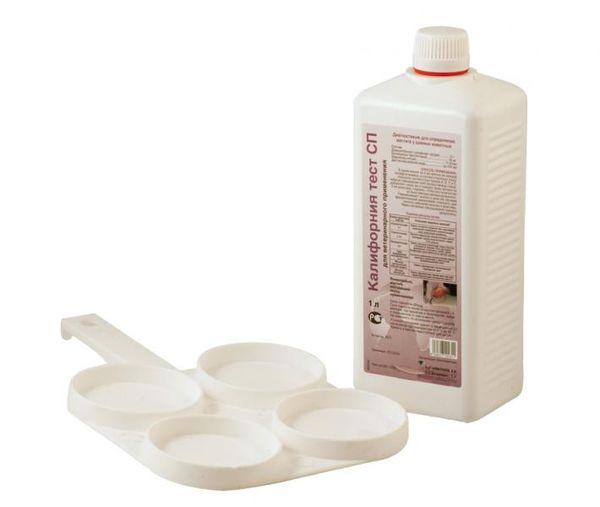

It is recommended to process grapes with this composition very carefully. In this case, it is worth using special protective equipment. Vapors of the mixture must not enter the respiratory system.
Industrial drugs for treatment
There are many ready-made preparations that can achieve excellent results in the fight against diseases and pests that cause yellowing of foliage.
Mancozeb
It is a fungicidal preparation that is highly effective. With its help, it is possible to protect the culture from diseases that are caused by infection with fungal microorganisms.
See also
Description and characteristics of the Syrah grape variety, where it grows
To read
Acrobat MC
This is a fairly reliable fungicide that helps to cope with most fungi. The active components of the substance are mancozeb and dimethomorph. It is recommended to water and sprinkle the bushes with the prepared solution.
Ditan
It is a contact fungicide based on mancozeb. With its help, it will be possible to easily eliminate the dangerous fungal disease - mildew. This term is called downy mildew.
Alirin-B
This is a biological preparation. With its help, it will be possible to suppress the activity of fungal microorganisms in the composition of the soil and on the surface of plants.
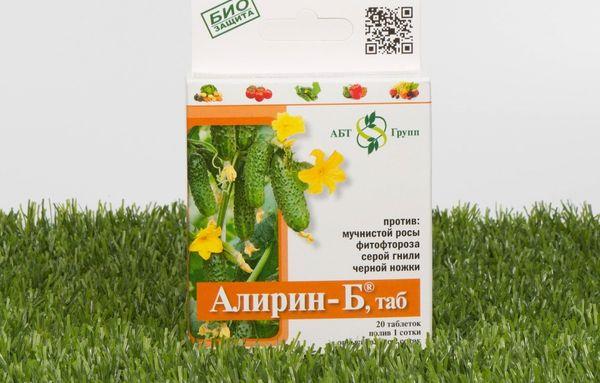

Planriz
It is a potent biological agent that is considered relatively safe. They can be sprayed on grapes even a day before harvest.
Fundazol
This remedy is recommended for use in the initial stages of the development of fungal infections. Fundazol is considered an effective fungicide.
Topaz
This remedy helps prevent the development of powdery mildew. The composition contains the substance penconazole. It is a systemic fungicidal agent that is highly effective.
Ridomil Gold
This is one of the most effective remedies. The drug is a contact-systemic fungicide that helps to eliminate the main fungal infections. The active ingredients are mefenoxam and mancozeb.
Thanos
This product is resistant to washing off. Its active substances are cymoxanil and famoxadone. The drug successfully eliminates fungi.
Top dressing or ash treatment
This substance is introduced into the soil or used for foliar dressing. The ash contains a lot of phosphorus and potassium. In addition, the substance has a pronounced antifungal effect.
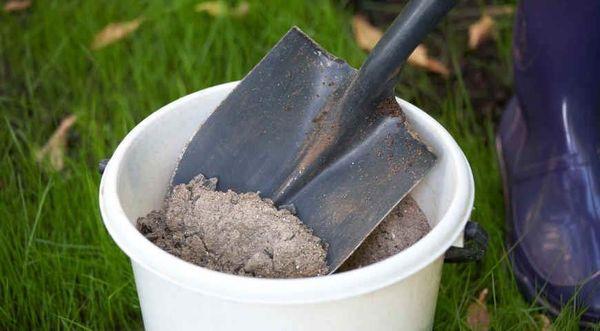

For foliar dressing, you will need 1 liter of ash. It is recommended to mix it with 2 liters of water. Leave to infuse for 3 days, strain and use for spraying bushes.Before using the composition, 4 liters of liquid are added.
To make the use of the ash solution effective, it should be dug into the furrows near the grape bushes. With the arrival of autumn, the bushes can be irrigated with an ash-based product. To get an effective composition, you need 200 grams of ash and 10 liters of water. To achieve good results, it is recommended to water each bush abundantly. 1 plant will require 3 liters of water.

